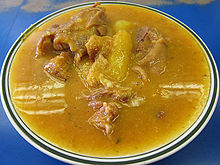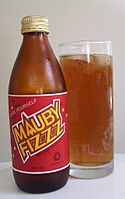- Dominican Republic cuisine
-
Dominican Republic cuisine is predominantly made up of a combination of Spanish, indigenous Taíno, and African influences, the first and last occurring over the last five centuries. Dominican cuisine resembles that of other countries in Latin America, those of the nearby islands of Puerto Rico and Cuba, most of all, though the dish names differ sometimes.
Breakfast can consist of eggs or meat and mangú (mashed plantain). A heartier version uses deep-fried meat, such as Dominican salami. Cheese is another popular accompaniment.
As in Spain, the largest, most important meal of the day is lunch. Its most typical form, nicknamed La Bandera ("The Flag"), consists of rice, red beans, meat (beef, chicken, pork, or fish), and salad.
Contents
Dishes and their origins
The Dominican Republic was formerly a Spanish colony. Many Spanish traits are still present, and people recognize a Latin American feel to the island and its cuisine. Many traditional Spanish dishes have found a new home in the Dominican Republic, some with a twist. African and Taíno dishes still hold strong, some of them unchanged.
All or nearly all food groups are accommodated in typical Dominican cuisine, as it incorporates meat or seafood; grains, especially rice, corn (native to the island[1]), and wheat; vegetables, such as beans and other legumes, potatoes, yuca, or plantains, and salad; dairy products, especially milk and cheese; and fruits, such as oranges, bananas, and mangos. However, there is heaviest consumption of starches and meats, and least of dairy products and non-starchy vegetables.
Sofrito, a sautéed mix of local herbs and spices, is used in many dishes. Throughout the south-central coast bulgur, or whole wheat, is a main ingredient in quipes and tipili, two dishes brought by Levantine Middle Eastern immigrants. Other favorite foods and dishes include chicharrón, pastelitos or empanadas, batata, pasteles en hoja (ground roots pockets), chimichurris, plátanos maduros (ripe plantain), and tostones.
Taíno dishes
 Chulito filling
Chulito filling
Spanish dishes
- Arroz con leche or arroz con dulce – Dominicans add star anise to the classic Spanish recipe
- Flan – there are many recipes of flan with a tropical twist from the fresh fruits on the island
- Paella – In the Dominican Republic paella is done with local fish and ground annatto instead of saffron
- Chicharrón – fried pork rinds
African dishes
 Mondongo beef tripe soup
Mondongo beef tripe soup
- Mangú – mashed, boiled plantain. Originated in west Africa and is known as fufu in Africa, Cuba and Puerto Rico.
- Mofongo – a popular Caribbean dish which originated in Puerto Rico and was later adapted to Dominican cuisine,[2] it is made from fried green plantains or fried yuca, seasoned with garlic, olive oil, and pork cracklings, then mashed with a little broth. Mofongo is usually served with a chicken broth soup.
- Pasteles en hojas – Root tamales. Its Origin leads back to African slaves in the island, Puerto Rico and Venezuela. Dominican Pateles en hoja are very similar to Puerto Rican pasteles but with less starchy tubers and less stuffing ingredients and more of a citrus taste.
- Mondongo – beef tripe soup. Its origins lead back to african slaves in the Dominican Republic.
- chen-chen - A corn dish originating in San Juan De La Maguana with african influences.
Other foods
 Bacalaíto and fried pork
Bacalaíto and fried pork
- Arepa – Venezuelan and Colombian bread made from corn. It is very popular as street food in the Dominican Republic
- chambre- legumes and meat stew. It has african origins in the poor rural parts of the Dominican Republic.
- Dulce de leche – a caramel or thick jam made from milk and sugar; its origins are unclear.
- Moros de gandules con coco – rice, peas, and coconut milk dish. This dish originated in samaná.
- rabo encendido- Spicy ox-tail stew.
- Sancocho – very hearty stew from either chicken, pork, shrimp or fish. The sancocho de siete carnes( seven meats sancocho) and sancocho de abichuelas (bean sancocho) are unique to the Dominican Republic.
- Niño envuelto – rice cake wrapped in cabbage leaf. A dish influenced by lebanese inmmigrants.
- Pastelitos – small version of empanadas stuffedwith dominican style seasoned meat.
- Yaroa - Chili cheese fries.
- Yanikeiki – Dominican version of Jonnycakes. A dish brought by sugar cane workes from the lesser antilles over a century ago.
- Chicharrón de pollo – fried boneless chicken.
- Tostones – fried plantain slices served flattened and salted. Popular all over Latin America.
- Bizcocho Dominicano - Dominican cake
- Habichuelas con dulce – sweet creamed beans dessert. Made with coconut milk, sweet potato chunks, etc.
- Molondrones guisados - Okra stew. Can be traced back to african slaves in the Dominican Republic.
- yuca y batatas fritas - fried sweet potatoes and cassava. This dish can be traced back to the taino indians that inhabited the island.
- carne mechada - Braised beef roll. Not to be confused to the Venezuelan dish of shredded meat also known as carne mechada.
- chapea
Beverages
- Morir Soñando - a popular orange juice, milk, and sugar drink
- Ponche - eggnog is very popular around Christmas time
- Mabí – juice made from colubrina bark or fruit, sometimes fermented, sometimes spiced
- Mama Juana
- Pera Piña
Geographical differences
What Dominicans tend to eat depends highly on where they live: whether near the sea or in the interior mountains. In either case, most Dominican meat dishes tend to involve pork, as pigs are farmed quite heavily on the island. Meat dishes tend to be very well cooked or even stewed in Dominican restaurants, a tradition stemming from the lesser availability of refrigeration on the island.
Seaside Dominican fishing villages will have great varieties of seafood, the most common being shrimp, marlin, mahi-mahi or dorado, and lobster. Most villagers more commonly dine on cheap, lesser-quality fish, usually stewed with la criolla, a type of rice. Premium seafood tends to be too expensive for the many locals, and is saved for the island's upper class and the tourist resorts.
Differences between Dominican cuisine and those of other parts of the West Indies include the milder spicing of the Dominican, which mainly uses onions, garlic, cilantro, cilantro ancho (culantro), ají cubanela (cubanelle pepper), and oregano.
References
- ^ "Food Crops". U.S. Library of Congress. http://countrystudies.us/dominican-republic/44.htm. Retrieved 2011-02-10.
- ^ Clara R. Gonzalez; , Ilana Benady, Jill Wyatt (2007). Traditional Dominican Cookery. Lulu.com. p. 56. ISBN 9945045016. http://books.google.com/books?id=RzKs7BO5eSwC&pg=PA56&dq=Mofongo+origin&lr=&num=30&as_brr=3&ei=NhTcScS7EYTyzQTujsDeDg.
Further reading
- Castro, Marianela; Clavé, Montse; Alcántara, Luz María (1996). Cocina Dominicana: Volume 2 of Cocinas de allí, aquí. Icaria Editorial. ISBN 8474262771, 9788474262773.
External links
North American cuisine Sovereign states - Antigua and Barbuda
- Bahamas
- Barbados
- Belize
- Canada
- Costa Rica
- Cuba
- Dominica
- Dominican Republic
- El Salvador
- Grenada
- Guatemala
- Haiti
- Honduras
- Jamaica
- Mexico
- Nicaragua
- Panama
- Saint Kitts and Nevis
- Saint Lucia
- Saint Vincent and the Grenadines
- Trinidad and Tobago
- United States

Dependencies and
other territories- Anguilla
- Aruba
- Bermuda
- Bonaire
- British Virgin Islands
- Cayman Islands
- Curaçao
- Greenland
- Guadeloupe
- Martinique
- Montserrat
- Puerto Rico
- Saint Barthélemy
- Saint Martin
- Saint Pierre and Miquelon
- Saba
- Sint Eustatius
- Sint Maarten
- Turks and Caicos Islands
- United States Virgin Islands
Categories:- Dominican Republic culture
- Dominican Republic cuisine
Wikimedia Foundation. 2010.


